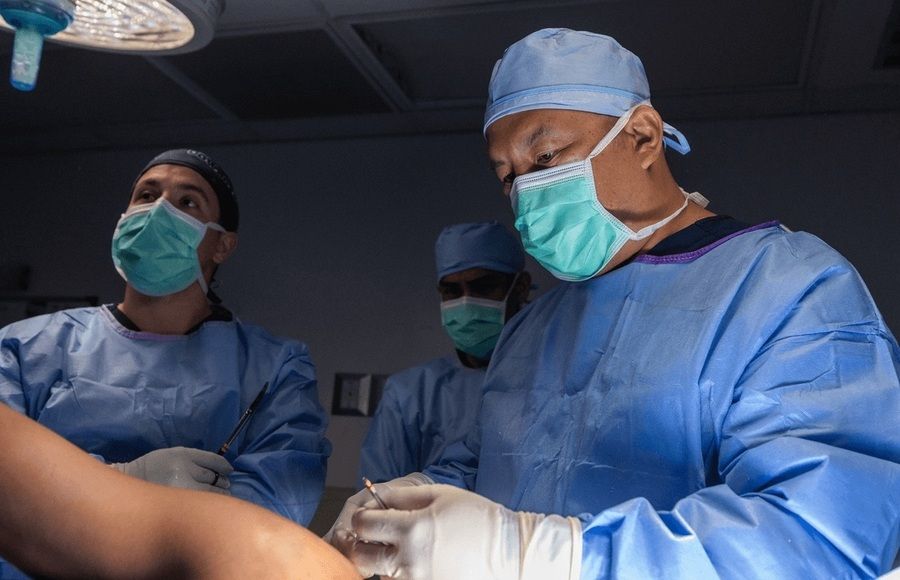What to Know About Hip or Femur Surgery
Hip and femur surgery from the best orthopedic surgeon in San Francisco can be life-changing for people struggling with pain, injury, or limited mobility. This article addresses the most common questions about these procedures, including what they entail, the differences between hip repair vs. hip replacement surgery, and what the recovery process truly involves.

Contents
Hip and femur problems can change the way you move, sit, and even sleep, making everyday life a challenge. These surgeries are not rare; in fact, more than 7 million orthopedic surgeries are performed annually in the United States, with many of them involving the hips, knees, and femur. Whether it’s repairing a torn labrum, stabilizing a fracture, or replacing a worn-out joint, hip and femur procedures are designed to restore function, relieve pain, and help people get back to the activities they enjoy.
Read on to get answers to the most common questions about hip and femur surgery, with the best orthopedic surgeon in San Francisco explaining the different types of procedures, and outlining what to expect before, during, and after treatment.
What Types of Hip and Femur Surgeries Are There?
When it comes to treating hip and femur problems, there isn’t a one-size-fits-all solution. Leading orthopedic surgeons choose the type of procedure based on the type of injury or damage to the joint, bone, or surrounding tendons. Some surgeries focus on repairing existing tissue, while others involve replacing damaged structures to restore strength and movement.
Here are the most common types of hip and femur surgeries you might hear about:
Labral Repair and Labral Tear Removal: Fixes or removes a torn labrum, the ring of cartilage that stabilizes the hip joint, thereby reducing pain and improving mobility.
Microfracture Surgery: This procedure involves creating small holes in the bone to stimulate new cartilage growth, thereby protecting the joint and alleviating discomfort.
Hip Fracture Repair: Stabilizes a broken femur near the hip with metal screws, rods, or plates, allowing the bone to heal properly.
Tendon Repairs: Restores muscle function by repairing torn proximal hamstring or quadriceps tendons, which are critical for walking and movement.
Hip Replacement: Replaces part or all of the hip joint with artificial components; this can be done through an anterior or posterior approach, depending on the patient’s needs.
When Is Getting Surgery on my Hip or Femur Needed?
Hip or femur surgery is usually considered when pain or injury makes it hard to move, stay active, or enjoy daily life. Common reasons include:
Severe hip arthritis that wears down the joint
Sports injuries that cause labral tears
Traumatic hip fractures from accidents or falls
In most cases, surgeons recommend trying conservative treatments first, such as physical therapy to strengthen the affected area, medications to reduce pain and swelling, or injections to improve joint function. Surgery becomes the next step when these options don’t provide enough relief, mobility continues to decline, or imaging shows that the joint or surrounding structures are getting worse.
What’s the Difference Between Hip Repair and Hip Replacement?
Hip repair and hip replacement are two very different procedures; both are considered when a hip joint is injured or deteriorated from disease:
Hip repair surgeries, such as labral repair, tendon repair, or stabilizing a hip fracture, focus on fixing the existing bone or soft tissue so the joint can heal and function normally again.
A hip replacement, on the other hand, involves removing part or all of the damaged joint and replacing it with artificial components designed to restore movement and reduce pain. Even within hip replacement, there are different surgical approaches: the anterior approach makes the incision at the front of the hip and often preserves more muscle, which can lead to a quicker recovery, while the posterior approach uses an incision at the back of the hip, giving the surgeon a wider view of the joint but sometimes requiring a more extended healing period.
How Long Does Recovery Take After Hip or Femur Surgery?
Recovery after hip or femur surgery can look very different depending on the type of procedure, but patience and following your post-surgical care are key:
For hip replacements, many patients are encouraged to stand or walk with support within just a few days, though it often takes three to six months before full strength and mobility return.
Surgeries that repair soft tissue, like labral or tendon repairs, usually require a period of limited movement to allow healing, followed by structured physical therapy to rebuild stability and strength.
When it comes to hip or femur fracture repairs, recovery often takes longer because the bone needs time to mend, and patients gradually increase weight-bearing over several months.
While the recovery timeline can vary, following your surgeon’s plan and committing to rehabilitation play the biggest role in achieving the best possible outcome.
What Are the Risks of Getting Hip or Femur Surgery?
Like any surgery, hip and femur procedures come with some risks. General surgical risks include complications such as infection, blood clots, or reactions to anesthesia, which can happen with many types of operations. Each procedure also carries its own specific risks; for example, repaired tendons may re-tear, a labral repair might not fully heal, or a hip replacement implant could loosen over time. The good news is that many of these risks can be minimized by working with an experienced orthopedic surgeon and carefully following post-operative instructions.
Finding the Best Orthopedic Surgeon in San Francisco
Choosing the right surgeon for something as important as hip or femur surgery takes more than credentials; it takes trust, precision, and genuine care. At our San Francisco practice, Dr. James Chen brings all three. As a board-certified and fellowship-trained orthopedic surgeon, he combines advanced surgical expertise with a patient-first approach, ensuring every step of your journey feels supported. From minimally invasive arthroscopic techniques that shorten recovery time to personalized treatment plans designed around your goals, Dr. Chen uses the latest technology while never losing sight of the human side of medicine.
We believe that your time with us, whether it’s a conversation before surgery or the follow-up care after, should be just as valuable as the procedure itself. That’s why patients count on us not only for excellent surgical outcomes, but also for the peace of mind that comes from being heard, cared for, and guided every step of the way.
Ready to get the careful, precision care you deserve from the best orthopedic surgeon in San Francisco?










